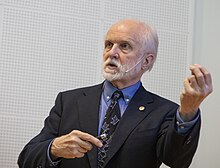A. James Hudspeth
A. James Hudspeth | |
|---|---|
 | |
| Alma mater | |
| Awards | Kavli Prize in Neuroscience (2018) |
| Scientific career | |
| Institutions |
|
A. James Hudspeth is the F.M. Kirby Professor at Rockefeller University in New York City, where he is director of the F.M. Kirby Center for Sensory Neuroscience. His laboratory studies the physiological basis of hearing.
Early life and education
As a teenager, James Hudspeth spent his summers working as a technician in the lab of neurophysiologist Peter Kellaway at Baylor College of Medicine.[1] Hudspeth was expelled from high school for mixing dangerous chemicals and other mischief.[1]
Hudspeth graduated from
He began a postdoctoral fellowship with Åke Flock at the Karolinska Institute, but returned soon afterwards to Harvard Medical School.[1][2]
Career
Following his postdoctoral training, Hudspeth was a professor at
Hudspeth has been an
Research
Hudspeth's research is focused on
Noted publications
- Holton T & A.J. Hudspeth A Micromechanical contribution to cochlear tuning and tonotopic organization. Science (1983); 222 (4623): 508–510[10]
- D.P. Corey, A.J. Hudspeth Kinetics of the receptor current in bullfrog saccular hair cells. J. Neurosci., 3 (1983): 962-976[6]
- Rosenblatt KP, Sun ZP, Heller S, A.J. Hudspeth Distribution of Ca2+-activated K+ channel isoforms along the tonotopic gradient of the chicken's cochlea. Neuron (1997): 19(5): 1061–1075[11] (note: this research was continued several years later taking advantage of newly available technology[12])
- A.J. Hudspeth How hearing happens. NEURON (1997): 19(5): 947-950[13]
- Lopez-Schier H, Starr CJ, Kappler JA, Kollmar R, A.J. Hudspeth Directional cell migration establishes the axes of planar polarity in the posterior lateral-line organ of the zebrafish. Dev CELL (2004): 7(3):401–412[14]
- Chan DK, A.J. Hudspeth Ca2+ current-driven nonlinear amplification by the mammalian cochlea in vitro. Nature Neuro (2005): 8(2):149–155[15]
- Kozlov AS, Risler T, A.J. Hudspeth Coherent motion of stereocilia assures the concerted gating of hair-cell transduction channels. Nature Neuro (2007): 10(1):87–92[16]
- Kozlov AS, Baumgart J, Risler T, Versteegh CP, A.J. Hudspeth Forces between clustered stereocilia minimize friction in the ear on a subnanometre scale. Nature. (2011): 474 (7351):376–9[17]
- Fisher JA, Nin F, Reichenbach T, Uthaiah RC, A.J. Hudspeth The spatial pattern of cochlear amplification Neuron (2012): 76(5):989–9[18]
Awards
- 1985 W. Alden Spencer Award
- 1991 K.S. Cole Award, Biophysical Society
- 1994 Charles A. Dana Award
- 1996 Rosenstiel Award
- 2002 Award of Merit, Association for Research in OtolaryngologyForces between clustered stereocilia minimize friction in the ear on a subnanometre scale. Kozlov AS, Baumgart J, Risler T, Versteegh CP, A.J. Hudspeth. Nature. 2011 May 22;474(7351):376-9. doi: 10.1038/nature10073.
- 2003 Ralph W. Gerard Prize, Society for Neuroscience
- 2010 Guyot Prize, University of Groningen[2]
- Elected member of the National Academy of Sciences and the American Academy of Arts and Sciences
- 2015 Elected member of the American Philosophical Society[19]
- 2018 Kavli Prize in Neuroscience (shared with Christine Petit and Robert Fettiplace)
- 2020 Louisa Gross Horwitz Prize (shared with Christine Petit and Robert Fettiplace).[20]
References
- ^ a b c d e f "The Ears Have It". The Scientist.
- ^ a b c d "A. James Hudspeth – Our Scientists". Our Scientists.
- ^ "The Rockefeller University » Scientists & Research". www2.rockefeller.edu.
- ^ "A. James Hudspeth, MD, PhD | HHMI.org". HHMI.org.
- ^ "James Hudspeth, MD, PhD | Duke Neurobiology". www.neuro.duke.edu. Archived from the original on 2016-03-09. Retrieved 2018-05-23.
- ^ PMID 6601694.
- ^ S2CID 33117543.
- PMID 31072932.
- PMID 29755320.
- PMID 6623089.
- S2CID 18165145.
- PMID 20479127.
- S2CID 16020028.
- PMID 15363414.
- PMID 15643426.
- PMID 17173047.
- PMID 21602823.
- PMID 23217746.
- ^ "APS Member History". search.amphilsoc.org. Retrieved 2021-02-22.
- ^ Louisa Gross Horwitz Prize 2020
